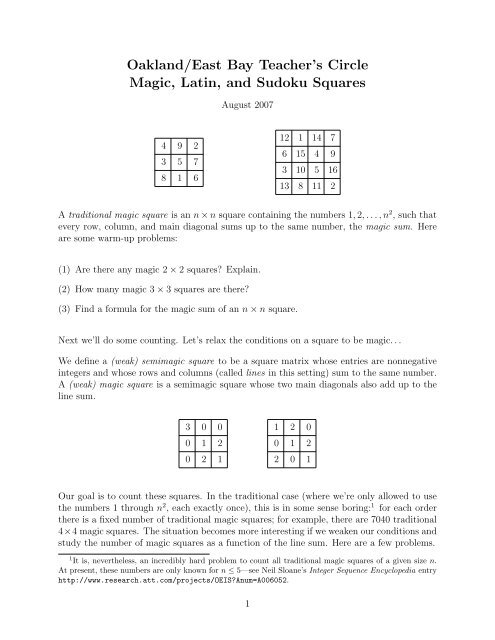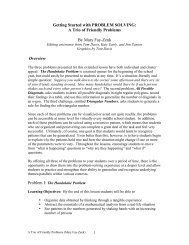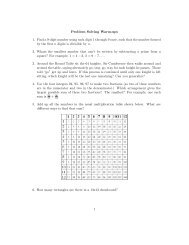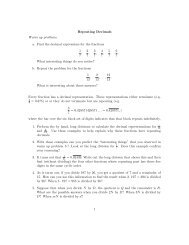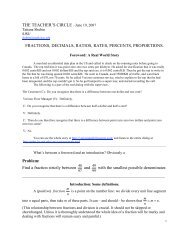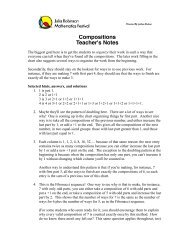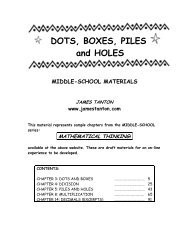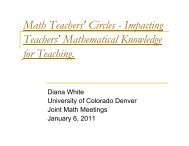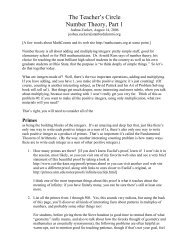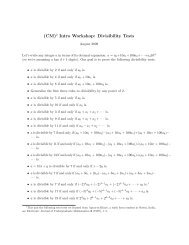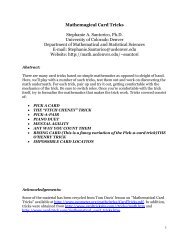Magic, Latin, and Sudoku Squares - Math Teachers' Circles
Magic, Latin, and Sudoku Squares - Math Teachers' Circles
Magic, Latin, and Sudoku Squares - Math Teachers' Circles
You also want an ePaper? Increase the reach of your titles
YUMPU automatically turns print PDFs into web optimized ePapers that Google loves.
Oakl<strong>and</strong>/East Bay Teacher’s Circle<br />
<strong>Magic</strong>, <strong>Latin</strong>, <strong>and</strong> <strong>Sudoku</strong> <strong>Squares</strong><br />
August 2007<br />
4 9 2<br />
3 5 7<br />
8 1 6<br />
12 1 14 7<br />
6 15 4 9<br />
3 10 5 16<br />
13 8 11 2<br />
A traditional magic square is an n × n square containing the numbers 1, 2, . . . , n 2 , such that<br />
every row, column, <strong>and</strong> main diagonal sums up to the same number, the magic sum. Here<br />
are some warm-up problems:<br />
(1) Are there any magic 2 × 2 squares Explain.<br />
(2) How many magic 3 × 3 squares are there<br />
(3) Find a formula for the magic sum of an n × n square.<br />
Next we’ll do some counting. Let’s relax the conditions on a square to be magic. . .<br />
We define a (weak) semimagic square to be a square matrix whose entries are nonnegative<br />
integers <strong>and</strong> whose rows <strong>and</strong> columns (called lines in this setting) sum to the same number.<br />
A (weak) magic square is a semimagic square whose two main diagonals also add up to the<br />
line sum.<br />
3 0 0<br />
0 1 2<br />
0 2 1<br />
1 2 0<br />
0 1 2<br />
2 0 1<br />
Our goal is to count these squares. In the traditional case (where we’re only allowed to use<br />
the numbers 1 through n 2 , each exactly once), this is in some sense boring: 1 for each order<br />
there is a fixed number of traditional magic squares; for example, there are 7040 traditional<br />
4×4 magic squares. The situation becomes more interesting if we weaken our conditions <strong>and</strong><br />
study the number of magic squares as a function of the line sum. Here are a few problems.<br />
1 It is, nevertheless, an incredibly hard problem to count all traditional magic squares of a given size n.<br />
At present, these numbers are only known for n ≤ 5—see Neil Sloane’s Integer Sequence Encyclopedia entry<br />
http://www.research.att.com/projects/OEISAnum=A006052.<br />
1
(1) How many 1 × 1 semimagic squares are there with line sum t<br />
(2) How many 1 × 1 magic squares are there with line sum t<br />
(3) How many 2 × 2 semimagic squares are there with line sum t<br />
(4) How many 2 × 2 magic squares are there with line sum t<br />
(5) Find a formula for the number of semimagic n × n squares with line sum 1.<br />
(6) Let (x ij ) 1≤i,j≤3<br />
be a magic 3 × 3 square.<br />
(a) Show that the center term x 22 is the average over all x ij .<br />
(b) Show that there are no magic 3 × 3 squares with line sum t, if t is not a multiple<br />
of 3.<br />
(7) The next two exercises are only fun if you know some linear algebra or, alternatively,<br />
have some feel for dimensions. Let’s denote the total number of semimagic <strong>and</strong> magic<br />
squares of order n <strong>and</strong> line sum t by S n (t) <strong>and</strong> M n (t), respectively. Prove that S n (t)<br />
grows like a polynomial of degree (n − 1) 2 or, alternatively, that the dimension of<br />
⎧⎛<br />
⎞<br />
⎪⎨ x 11 · · · x 1n<br />
⎜<br />
⎟<br />
⎝ . . ⎠ ∈ R n2 : x jk ≥ 0,<br />
⎪⎩<br />
x n1 . . . x nn<br />
∑<br />
∑ j x jk = 1 for all 1 ≤ k ≤ n<br />
k x jk = 1 for all 1 ≤ j ≤ n<br />
equals (n − 1) 2 . (You may start with the cases n = 1, 2, 3 to get a feel for this dimension<br />
computation.)<br />
(8) Prove that M n (t) grows like a polynomial of degree (n − 1) 2 − 2.<br />
⎫<br />
⎪⎬<br />
⎪⎭<br />
(1)<br />
A few magic remarks. . . The problem of counting magic squares (other than traditional<br />
magic squares) seems to have occurred to anyone only in the twentieth century, no doubt<br />
because there was no way to approach the question previously. The first formulas—beyond<br />
our exercises—addressing the counting problem, namely<br />
<strong>and</strong><br />
S 3 (t) = 1 8 t4 + 3 4 t3 + 15<br />
8 t2 + 9 4 t + 1<br />
{<br />
2<br />
9<br />
M 3 (t) =<br />
t2 + 2 t + 1 if 3|t,<br />
3<br />
0 otherwise,<br />
were established by Percy Macmahon in 1915. You might have noticed that S 1 (t), S 2 (t),<br />
<strong>and</strong> S 3 (t) are all polynomials in t. This evidence suggests that S n (t) is, in fact, a polynomial<br />
for all n, a theorem from 1973 which is independently due to Eugène Ehrhart <strong>and</strong> Richard<br />
Stanley. Our examples of M 2 (t) <strong>and</strong> M 3 (t) show already that M n (t) is in general not a<br />
polynomial. In fact, there is plenty of reason to conjecture that M n (t) is not a polynomial<br />
for all n > 1, but this conjecture is still open for n ≥ 6.<br />
2
The sets of the form (1) are the Birkhoff polytopes B n , named after Garrett Birkhoff, who<br />
proved that the extremal points of B n are the permutation matrices. A long-st<strong>and</strong>ing open<br />
problem is the determination of the (relative) volume of B n , which is known only for n ≤ 10.<br />
This volume equals—as you may try to prove—the leading coefficient of S n (t), a fact that<br />
asserts that the computation of S n (t) is generally hard.<br />
Ok—it’s time to play <strong>Sudoku</strong>. . .<br />
6 5<br />
5 6<br />
5 8 9<br />
2 1 6 7<br />
1 7 9 6<br />
7 6 2 3<br />
9 3 2 7<br />
3 7 4 6<br />
6 9 1 3<br />
1 9<br />
5 7<br />
7 3 8 1<br />
5 4<br />
5 4 1 3<br />
4 1<br />
3 7 9 2 8 6<br />
8 6 1 4 5 3<br />
A <strong>Sudoku</strong> square is a 9 × 9 grid filled with nine symbols (such as the numbers from 1 to 9)<br />
in such a way that each row, column, <strong>and</strong> the nine 3 × 3 subsquares (shown above) contain<br />
each symbol exactly once. If we leave out the last condition, we get the definition of a <strong>Latin</strong><br />
square, i.e., <strong>Sudoku</strong> squares are special cases of <strong>Latin</strong> squares. There are quite a number of<br />
famous long-st<strong>and</strong>ing open problems connected to <strong>Latin</strong> squares.<br />
In a <strong>Sudoku</strong> puzzle, the square contains some entries (called clues), <strong>and</strong> the goal is to complete<br />
the <strong>Sudoku</strong> square. In the classical setting, the clues are chosen such that there is only one<br />
way to complete each square. You may try your luck with the two <strong>Sudoku</strong> puzzles above<br />
(caveat: If you’ve never played a <strong>Sudoku</strong> puzzle, watch out—these squares are addictive).<br />
We will work on two problems regarding <strong>Sudoku</strong> squares:<br />
(1) How many <strong>Sudoku</strong> squares are there<br />
(2) What is the minimum number of clues that yield a unique solution to a <strong>Sudoku</strong> puzzle<br />
These are hard questions. In fact, (1) was answered only last year (the number of <strong>Sudoku</strong><br />
squares is 6 670 903 752 021 072 936 960), <strong>and</strong> (2) remains open (it is conjectured that the<br />
minimum number is 17). So we will simplify the problems <strong>and</strong> work with 4 × 4 <strong>Sudoku</strong><br />
squares. The next page contains many empty 4 × 4 squares for you to experiment with<br />
questions (1) <strong>and</strong> (2) in the 4 × 4 case.<br />
3
A few websites<br />
http://mathworld.wolfram.com/<strong>Magic</strong>Square.html (basic definitions)<br />
http://mathforum.org/alej<strong>and</strong>re/magic.square.html (classroom activities, lots of links)<br />
http://pasles.org/Franklin/index.html (Franklin squares)<br />
http://mathforum.org/te/exchange/hosted/suzuki/<strong>Magic</strong>Square.html (many many examples,<br />
lots of links)<br />
http://www.grogono.com/magic/index.php (construct your own magic square)<br />
http://www.jcu.edu/math/vignettes/magicsquares.htm (nice description of construction)<br />
http://en.wikipedia.org/wiki/<strong>Latin</strong> square (latin squares)<br />
<strong>Latin</strong> <strong>Squares</strong>:<br />
http://en.wikipedia.org/wiki/<strong>Latin</strong> square<br />
http://mathworld.wolfram.com/<strong>Latin</strong>Square.html<br />
http://www.cut-the-knot.org/arithmetic/latin3.shtml<br />
<strong>Sudoku</strong>:<br />
http://en.wikipedia.org/wiki/<strong>Sudoku</strong><br />
http://en.wikipedia.org/wiki/<strong>Math</strong>ematics of <strong>Sudoku</strong><br />
http://www.websudoku.com<br />
http://theory.tifr.res.in/ sgupta/sudoku<br />
http://www.maa.org/editorial/mathgames/mathgames 09 05 05.html<br />
http://www.geometer.org/mathcircles/sudoku.pdf<br />
http://mathworld.wolfram.com/<strong>Sudoku</strong>.html<br />
5


